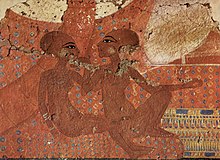Neferneferuaten Tasherit
| Neferneferuaten Tasherit | |||||||||||
|---|---|---|---|---|---|---|---|---|---|---|---|
| King's Daughter | |||||||||||
 Neferneferuaten Tasherit (right) and Neferneferure on a wall painting in the King's house | |||||||||||
| Egyptian name |
| ||||||||||
| Dynasty | 18th Dynasty | ||||||||||
| Father | Akhenaten | ||||||||||
| Mother | Nefertiti | ||||||||||
Neferneferuaten Tasherit or Neferneferuaten the younger (
.Family
Neferneferuaten was born between ca. year 8
Life

One of the earliest depictions of Neferneferuaten Tasherit is on a mural from the King’s House in Amarna. She is depicted sitting on a pillow with her sister Neferneferure. The fresco is dated to ca. year 9 of Akhenaten, and the entire family is depicted, including the baby Setepenre.[1]
Neferneferuaten Tasherit is depicted in several tombs in Amarna and appears on monuments. A statue base originally from Amarna, but later moved to Heliopolis, mentions the
In the tomb of
She is depicted at the Durbar in year 12 in the tomb of the Overseer of the royal quarters Meryre II in Amarna. Akhenaten and Nefertiti are shown seated in a kiosk, receiving tribute from foreign lands. The daughters of the royal couple are shown standing behind their parents. Neferneferuaten is the first daughter in the lower register. She is holding an object which is too damaged to identify. Her sisters Neferneferure and Setepenre are standing behind her. Neferneferure is shown holding a pet gazelle and Setepenre is shown reaching over to pet the animal.[4]
Neferneferuaten also appears in the award scene of Panehesy. She is shown standing in the building near the window of appearance as her parents, Akhenaten and Nefertiti, bestow honors upon the first servant of the Aten named Panehesy. In another scene in this tomb Neferneferuaten and her three older sisters all accompany their parents who are shown offering flowers to the Aten. The four royal daughters are all shown holding bouquets of flowers.[4]
Neferneferuaten Tasherit is shown with her sisters

Final years and death
It is unknown what became of Neferneferuaten Tasherit, but it has been suggested she died before Tutankhamun and Ankhesenpaaten came to the throne.[1] It is possible she was one of the persons buried in chamber in the Royal Tomb in Amarna.[3]
It was previously suggested by James Allen in 2009[6] that she might be identified as Akhenaten's co-regent.[7] whose exact identity is still disputed, but who could have been a woman.
- However, in an updated 2016 article, James Allen has now repudiated his previous opinion that Neferneferuaten-tasherit was the female pharaoh Neferneferuaten. Allen now agrees that this female king was indeed Nefertiti instead with the publication of the Year 16 date showing that Nefertiti was still alive in Akhenaten's second last year of rule.[8] Other women who have been suggested as candidates for the identity of this female ruler are Queen Nefertiti (her mother) and her older sister Meritaten.[5]
References
- ^ ISBN 0-670-86998-8
- ISBN 0-500-27621-8
- ^ ISBN 0-500-05128-3
- ^ ISBN 1-55540-966-0
- ^ ISBN 978-977-416-304-3
- ^ Causing His Name to Live: Studies in Egyptian Epigraphy and History in Memory of William J. Murnane
- ^ J.P. Allen, The Amarna Succession, in Causing His Name to Live: Studies in Egyptian Epigraphy and History in Memory of William J. Murnane, ed. P. Brand and L. Cooper, Culture and history of the Ancient Near East 37. Leiden: Brill, 2009 p. 14.
- ^ James Allen, “The Amarna Succession Revised,” GM 249 (2016), pp.9-13



